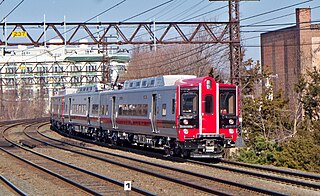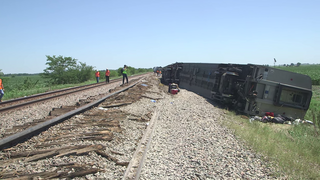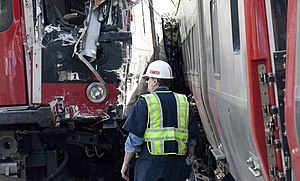
On March 15, 1999, Amtrak's southbound City of New Orleans passenger train collided with a semi-trailer truck in the village of Bourbonnais, Illinois, United States. Most of the train derailed, killing eleven people. A National Transportation Safety Board (NTSB) investigation into the accident attributed the cause to the truck driver trying to beat the train across a grade crossing. The NTSB's recommendations from the accident included increased enforcement of grade crossing signals, the installation of train event recorders at all new or improved grade crossings, and procedures to provide emergency responders with accurate lists of all crew members and passengers aboard trains. The city of Bourbonnais erected a memorial near the site to commemorate those killed in the accident.

The New Haven Line is a 72.7 mi (117.0 km) commuter rail line operated by the Metro-North Railroad in the U.S. states of New York and Connecticut. Running from New Haven, Connecticut, to New York City, the New Haven Line joins the Harlem Line in Mount Vernon, New York, and continues south to Grand Central Terminal in Manhattan. The New Haven Line carries 125,000 passengers every weekday and 39 million passengers a year. The busiest intermediate station is Stamford, with 8.4 million passengers, or 21% of the line's ridership.

Bridgeport station is a shared Amtrak, Metro-North Railroad, and CT Rail train station along the Northeast Corridor serving Bridgeport, Connecticut and nearby towns. On Metro-North, the station is the transfer point between the Waterbury Branch and the main New Haven Line. Amtrak's inter-city Northeast Regional and Vermonter service also stop at the station, as do some CT Rail Shore Line East trains. In addition the transfer point for Greater Bridgeport Transit Authority buses, the departure point for the Bridgeport & Port Jefferson Ferry across Long Island Sound to Port Jefferson, New York, and both the Total Mortgage Arena and the Hartford Healthcare Amphitheater are located adjacent to the station.

Positive train control (PTC) is a family of automatic train protection systems deployed in the United States. Most of the United States' national rail network mileage has a form of PTC. These systems are generally designed to check that trains are moving safely and to stop them when they are not.

The 2008 Chatsworth train collision occurred at 4:22:23 p.m. PDT on September 12, 2008, when a Union Pacific Railroad freight train and a Metrolink commuter rail passenger train collided head-on in the Chatsworth neighborhood of Los Angeles, California, United States.

During the afternoon rush hour of June 22, 2009, a subway train wreck occurred between two southbound Red Line Washington Metro trains in Northeast, Washington, D.C., United States. A moving train collided with a train stopped ahead of it; the train operator along with eight passengers died, and 80 people were injured, making it the deadliest crash in the history of the Washington Metro.

There have been numerous incidents on the Washington Metro over its history, including several collisions causing injuries and fatalities, and numerous derailments. The Washington Metropolitan Area Transit Authority (WMATA) has been criticized for disregarding safety warnings and advice from experts.

On the morning of December 1, 2013, a Metro-North Railroad Hudson Line passenger train derailed near the Spuyten Duyvil station in the New York City borough of the Bronx. Four of the 115 passengers were killed and another 61 injured; the accident caused $9 million worth of damage. It was the deadliest train accident within New York City since a 1991 subway derailment in Manhattan, and the first accident in Metro-North's history to result in passenger fatalities. The additional $60 million in legal claims paid out as of 2020 have also made it the costliest accident in Metro-North's history.

The 1990 Back Bay, Massachusetts train collision was a collision between an Amtrak passenger train, the Night Owl, and a Massachusetts Bay Transportation Authority (MBTA) Stoughton Line commuter train just outside Back Bay station in Boston, Massachusetts, United States. An investigation by the National Transportation Safety Board (NTSB) found that the Amtrak train entered a speed-restricted curve at excessive speed, causing the train to derail and crash into the MBTA commuter train on an adjacent track. Although no one was killed in the accident, 453 people were injured and Back Bay station was closed for six days. Total damage was estimated at $14 million. The accident led to new speed restrictions and safety improvements in the vicinity of Back Bay and a revamp of Amtrak's locomotive engineer training program.

On the evening of February 3, 2015, a commuter train on Metro-North Railroad's Harlem Line struck a passenger car at a grade crossing near Valhalla, New York, United States, between the Valhalla and Mount Pleasant stations, killing six people and injuring 15 others, seven very seriously. The crash is the deadliest in Metro-North's history, and at the time the deadliest rail accident in the United States since the June 2009 Washington Metro train collision, which killed nine passengers and injured 80.

The 2015 Philadelphia train derailment of a New York City-bound Amtrak train in Kensington, Philadelphia, Pennsylvania in the United States resulted in multiple passenger injuries and deaths and disrupted Amtrak service for several days afterward due to the resulting investigation and removal of the wrecked train cars.

On the evening of July 18, 2013, a CSX freight train carrying municipal solid waste on tracks of the Hudson Line along the Harlem River Ship Canal in the New York City borough of The Bronx partially derailed between the Marble Hill and Spuyten Duyvil stations. While no one was injured, the derailment caused over US$800,000 in damage and took several days to clean up. Commuter rail service by Metro-North Railroad, which owns the line, was suspended for two weekends in order to fully restore normal operations.

On April 3, 2016, Amtrak train 89, the southbound Palmetto, struck a backhoe while travelling through Chester, Pennsylvania, killing two track workers and derailing the locomotive, as well as damaging the first two cars.

On December 18, 2017, Amtrak Cascades passenger train 501 derailed near DuPont, Washington, United States. The National Transportation Safety Board's (NTSB) final report said regional transit authority Sound Transit failed to take steps to mitigate a curve at the accident location, and inadequately trained the train engineer. The train was making the inaugural run of the Point Defiance Bypass, a new passenger rail route south of Tacoma, Washington, operated by Amtrak in partnership with state and local authorities in Oregon and Washington, on right-of-way owned and operated by Sound Transit. The bypass was intended to reduce congestion and separate passenger and freight traffic, and was designed for faster speeds and shorter travel times, saving ten minutes from Seattle to Portland compared with the previous route used by Cascades.

On September 25, 2021, at 3:56 p.m. Mountain Daylight Time, Amtrak passenger train 7/27, the westbound Empire Builder, carrying 149 passengers and 16 crew members, derailed west of the town of Joplin, Montana, United States. The train consisted of two locomotives and ten cars, eight of which derailed.

On June 27, 2022, the Southwest Chief, a passenger train operated by Amtrak, derailed near the small town of Mendon, Missouri. The derailment was caused by the train striking a dump truck that was obstructing the crossing of County Road 113, about three miles (4.8 km) southwest of Mendon. Four people were killed in the wreck: three passengers on board the train and the truck driver, with up to 150 people injured.





















